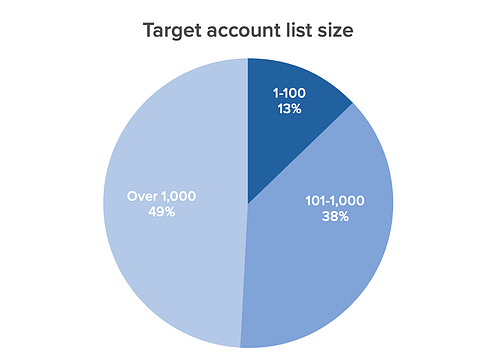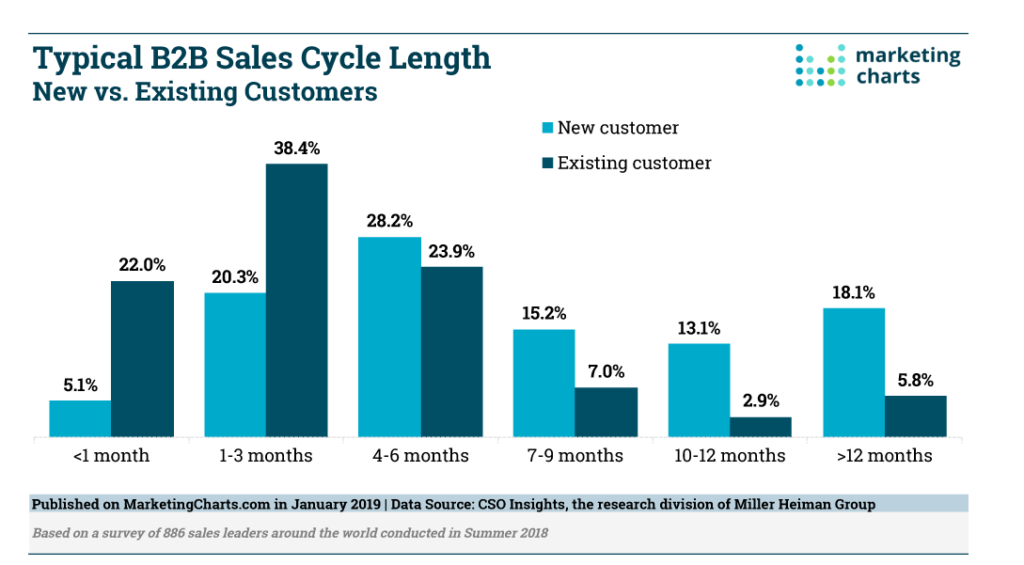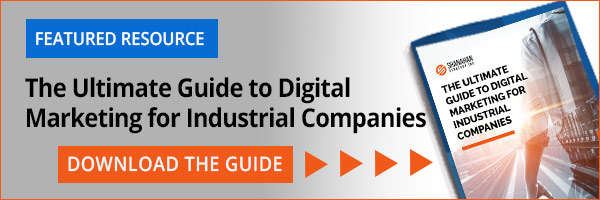Manufacturers currently face several challenges, such as complex sales processes, limited market data, and a select number of potential new customers. Combined with antiquated marketing strategies and inadequate technology, manufacturers are climbing an uphill battle to build a healthy sales pipeline. However, account-based marketing (ABM) for manufacturers provides an alternative method.
In this post, you’ll discover how you can leverage an ABM strategy to maximize your sales and marketing efforts. With 70% of B2B marketers using ABM in 2021, you can streamline your processes by identifying contacts, creating custom content, and getting more qualified prospects in your pipeline.
Ready to learn more about ABM for manufacturers? Let’s dive in!
Key Takeaways:
- ABM targets high-value accounts to generate qualified deals.
- Maximize engagement with valuable opportunities to speed up your sales cycle.
- Deliver personalized content like email and paid ads to delight your accounts.
What is ABM for Manufacturers?
According to a Forrester report, 62% of marketers agree that they can measure a positive impact on revenue and earned customers after adopting an ABM strategy. ABM is a strategy that allows sales and marketing teams to target the best-suited accounts for your products and turn them into repeat customers.
In the modern age of fighting for your customer’s attention, ABM focuses only on key high-value opportunities to increase ROI instead of targeting every and anyone. In turn, you’re able to use personalization better, align sales and marketing teams, and generate more conversions.
The critical components of an ABM strategy include:
- Targeting the right opportunities: Use technology to manage accounts that will result in the highest ROI in a faster time.
- Engaging across multiple channels: Run coordinated campaigns to deliver the right messages on the target’s preferred platform.
- Optimizing and measuring campaigns: Track your progress to analyze specific campaigns and accounts to stay on budget.
For B2B companies, 84% of marketers report that ABM outperforms other investments, and it generates 208% more revenue when teams align around the targeted strategy.
6 Key Steps to Implement Your ABM Program
While an inbound marketing strategy might work for some B2B companies, ABM helps you boost revenue and access in-depth performance metrics that wouldn’t otherwise be available.
Here are the critical steps to get your strategy off the ground:
- Step 1: Discover your high-value accounts through data and intelligence
- Step 2: Map your account’s characteristics and key decision-makers
- Step 3: Create personalized content that addresses the account’s challenges
- Step 4: Select the key channels to communicate with your accounts like web, email, and mobile
- Step 5: Execute your campaigns across designated marketing channels
- Step 6: Continue to measure and optimize the campaigns to drive results
4 Key Benefits of ABM for Manufactures
While ABM is not a new strategy, it’s having a serious comeback with better technology and personalization available. For manufacturers facing long sales cycles and niche products, ABM provides a unique opportunity to generate more quality leads faster.
Here are a few ways ABM can help boost your pipeline:
1. Generate High-Quality and Qualified Sales Opportunities
The foundation of any ABM platform is identifying and prioritizing valuable targets through market and business intelligence. However, this will take a lot of collaboration between your sales and marketing teams to stay aligned.
You’ll want to categorize these accounts based on the following characteristics:
- Likelihood to repeat a purchase
- Market influence
- Annual revenue
- Geography
- Budget
- Number of employees
- Vertical or industry
- Technology usage
- Organizational maturity
Your targets should identify your ideal customer profile (ICP) and total addressable market (TAM). By aligning your sales and marketing teams on the best-suited accounts, you’re able to focus your company efforts on turning every marketing qualified lead (MQL) into a sales qualified lead (SQL), instead of worrying about poor quality leads.

If your account list is too extensive, you can use tiers to prioritize opportunities based on data points and “dream” accounts. For example, tier one includes the highest value ICPs, and tier two includes strong fits but lower lifetime value. Tier three consists of ICPs only worth pursuing with more advertising dollars.
Once your teams have categorized and prioritized the account lists, you can deliver personalized campaigns to decision-makers and collect data to generate more opportunities.
2. Maximize Effort to Build Awareness and Engagement
Engagement is the best way to measure performance as you start to connect with your ICPs.
While inbound marketing tracks typical success metrics like leads or MQL rates, you need to measure your opportunity conversion rates and how frequently you’re reaching out to accounts.
How should you engage with these accounts? When it comes to manufacturing, working off a cold list or the “spray and pray” strategy can be meaningless, especially if you’re trying to target a buyer’s committee or association. Your marketing tactics will remain similar to inbound campaigns, such as:
- Retargeting
- Personalized emails
- Paid social advertising – 56% of advertisers currently use LinkedIn for ABM efforts!
- Display ads
- Content marketing like webinars or events
- Direct mail
- Video
Since you’re orchestrating your marketing tactics at a higher level, each ABM campaign will be highly personalized and catered to the account’s pain points and needs. Not only will this help get your foot in the door and drive better engagement, but your sales team is also more likely to reach out to someone who is engaging with your materials than one who has never shown interest.
3. Speed Up the Sales Cycle
How long is your sales cycle? 30% of B2B companies say it takes at least four months to close a new deal, and 46% say it takes seven months or more.

Now that you’re engaging with valuable accounts and finding clever ways to capture their attention, you also need to convert them into loyal customers. Since manufacturers face long sales cycles and larger deal volumes, an ABM strategy takes a more linear approach to follow the opportunity through every stage of the buyer cycle.
Instead of a cut-and-dry handoff, marketing and sales work together to find better ways to nurture the ABM accounts. For example, marketing can send a retargeting or email campaign to reinforce sales messages. Marketing can also find new channels to engage with the accounts to deliver educational content or penetrate the contact deeper.
In turn, you’re able to unlock bottlenecks in the customer journey to increase efficiency and the sales cycle speed.
4. Upsell and Cross-Sell to Existing Customers
While ABM for manufacturers is excellent for acquiring new accounts, you can also use it to sell products or services to existing customers. Your marketing team can help identify customers who might be a good fit for different product lines, gather data, and drive awareness with targeted campaigns.
Your sales team can then use the data from marketing to initiate new conversations with existing customers to start a conversation and cross-sell products. Overall, this leads to more productive discussions and helps you find new opportunities to build brand loyalty.
Quick Ideas to Get Your ABM Campaign Started
It’s important to note that ABM is not a list of tactics you send to accounts; it’s a dedicated and holistic strategy to create more long-lasting connections. If you’re ready to start developing content, you need to consider who your ICPs are and what they need to guide your marketing tactics. Here are a few examples:
Run a Targeted Paid Media Campaign
Platforms like LinkedIn and AdRoll offer advanced targeting techniques to reach the correct accounts. While sponsored posts and display ads aren’t the most personalized marketing tactic, it’s a great way to streamline your efforts and build brand awareness.
For example, you can upload custom ABM company and contact lists to advertise on LinkedIn. LinkedIn will connect the contact information to their LinkedIn profile and deliver text, video, and direct message campaigns. You’re also able to set your budget and use a LinkedIn form to capture their information.
Create Automated Email Nurtures Based on Behaviors
If you identify 25 key accounts, you can create personalized email nurtures and send them to the key decision-makers. While you’ll want to keep these emails automated, the content should still be personalized and deliver value. For example, consider creating a quick video or blog post that targets the account’s pain points.
Personalize Direct Mailers
Sure, emails and paid advertising are easy to automate, but nothing compares to a handwritten note or personalized mailer. It not only shows that you’re willing to put in extra effort to win business, but it also helps you differentiate your brand from the competition.
To take things up a notch, send mailers from a specific person in your company — CEO, CFO, Lead Engineer, or VP of Sales — and tailor the messaging to the account’s needs. While personalized mailers can take more time, you’re more likely to capture their attention and cut through all the digital noise.
Boost Your Manufacturing Pipeline with an ABM Strategy
If you’re looking to improve your sales cycle and retain your dream clients, an ABM strategy can help manufacturing companies attract and convert high-quality accounts. Instead of waiting for accounts to find your company with traditional inbound tactics, you can leverage ABM to deliver personalized campaigns to the right decision-makers and increase ROI.
Ready to implement a better marketing strategy? Get started with Shanahan Strategy today.

